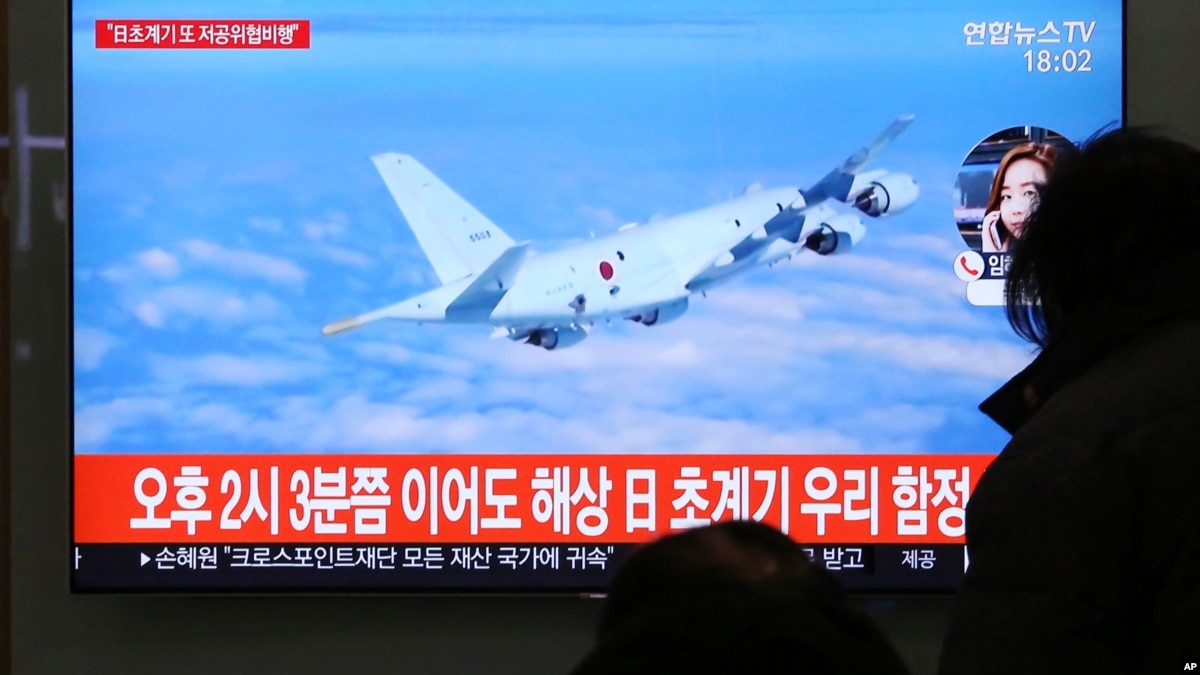
Seoul has accused Tokyo of repeated low-altitude, “provocative” flights over its naval vessels. It’s something the Japanese government denies and the two sides have been going back and forth publicly for over a month disputing one another’s accounts as bilateral relations sink.
Shim Jae-ok, a Professor at the Department of Aviation at Sehan University and a former Navy pilot, tells VOA these types of incidents do happen from time to time and “usually two sides are willing to sort out through working-level talks as an alliance.”
“However, this time Japanese politicians, including Prime Minister [Shinzo] Abe and the Minister of Defence extraordinarily mentioned it to the public,” said Shim.
Grant Newsham, Senior Research Fellow with the Japan Forum for Strategic Studies in Tokyo, suspects the reason for the Abe and the Japanese government to take this latest dispute public was that the senior level of government had “enough” from South Korea, especially with the latest court rulings ordering Japanese companies to compensate forced laborers from World War Two.
However, he said what is often overlooked is that the South Korean and Japanese militaries have a fairly good track record of working together throughout the years.
Newsham said, “The real sort of problem here is at the top levels, not so much at the military to military level.”
Conflicting stories
In late December, South Korean naval vessels were responding to distress signals sent by a North Korean fishing vessel that was drifting into international waters in the waters between the two countries.
Japan claims its Maritime Self Defense Force P-1 aircraft was targeted with fire control radar from the South Korean warship Gwanggaeto and felt threatened. However, South Korea said they felt threatened because of the track and low altitude of the Japanese craft.
Since the initial incident, South Korea has reported a least three other incidents where it says Japanese aircraft approached its vessels at a height of 60-70 meters, rather than the standard 150 meters. Seoul characterized these flights as “provocative” acts.
Shim, who flew naval aircraft for 30 years, said 150 meters is their standard limit to determine what is a threatening flight by an approaching aircraft.
“However,” he said, “looking at the path of the Japanese aircraft, it carried out ‘rigging.’”
That’s an operational term for aircraft carrying out surveillance flights or flying in such a way that threatens a hostile force.
“Modern aircraft are equipped with technology to observe [targets] from a distance and it is rare to do reconnaissance flight with rigging,” he said.
Because of this, Shim said the only time an aircraft would want to make itself visible to another force, would be to carry out the practice of rigging.
“So that’s why the Korean military called the flights threatening,” Shim said.
Ending the row
Last week South Korean Foreign Minister Kang Kyung-wha met with Japanese Foreign Minister Taro Kono on the sidelines of the World Economic Forum Annual Meeting in Davos, Switzerland to address the issue.
Japan had hoped to use the meeting to seek out a remedy to end the rift, but Kang was quoted as saying the incidents were “very annoying” and “regrettable” as the session was getting underway.
Kono responded by saying Seoul’s announcement of additional alleged low altitude flights was “regrettable” and denied that Japanese planes conducted low-altitude flights.
The head of South Korea’s Joint Chiefs of Staff’s operational headquarters, Suh Wook, said if Japan continues to carry out such maneuvers, “We will definitely take a strong action in line with our military’s code of conduct.”
Japan’s Kyodo news reported Tokyo is canceling a Japanese destroyer’s call to the South Korean port city of Busan over the continuing incidents.
Seoul says it hasn’t received any official updates from Japan about the vessel canceling its participation in joint exercises.
In addition, the commander of the South Korean Navy's First Fleet has called off a planned trip to Japan next month.
Keeho Yang, a professor in the Department of Japanese studies at Sungkonghoe University, believes the issues between the two militaries will pass relatively soon.
“[South Korea - Japan] security is important and they have a rule that keeps the two militaries cooperating. In addition, there’s the GSOMIA (General Security of Military Information Agreement), so there is no change in the basic principle [of how the two militaries are supposed to interact,” said Yang.
But Shim cautioned, “If the [South] Korean side continues to feel threatened, they need to make a responsive plan and that result in military conflict.”
He said that would be an extreme situation, but possible.
Newsham says it's easy to brush aside the current disagreements and assume they will "just blow over " and as time passes there will be other "things that take up people's time and attention."
But he says, "One shouldn't just dismiss or discount the South Korean resentment [in Japan] and just how there is a potential for these two nations to sort of shoot at each other. It's not unthinkable,” he said.
He said this could become an issue if the United States were to leave the Korean Peninsula.
Lee Ju-Hyun contributed to this report.
Read More No End in Sight for Radar Dispute Between Seoul and Tokyo : http://bit.ly/2CMAHeg
No comments:
Post a Comment